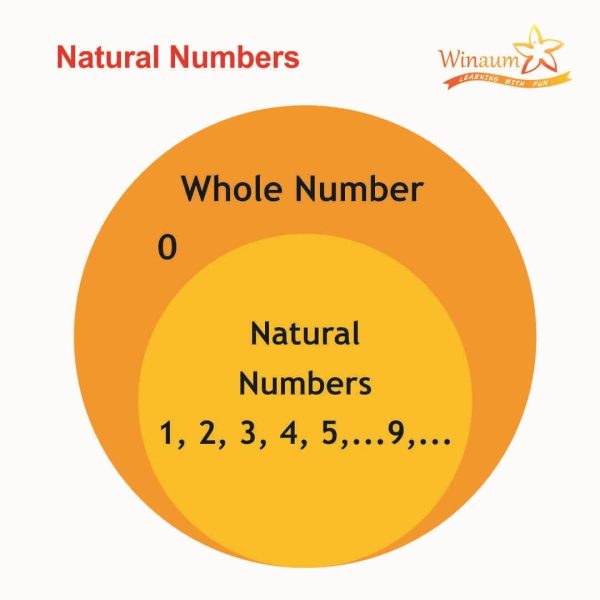Natural Numbers - Properties, Examples and Definition
Updated 12th April 2023

Table of Contents
Natural Numbers are numbers that are used for counting and they start from the numbers 1,2,3…. and so on. Here you will all the information about Natural Numbers, the Definition and Properties of Natural Numbers with Examples. You will find an in-depth explanation about Natural Numbers.
What is a Natural Number
Natural Numbers are those that have all the positive integers from 1 to infinity as part of the number system.. We can also say that natural numbers are the counting numbers starting from 1 and go up to infinity. It is usually denoted as N.
Different Properties of Natural Numbers
- Closure Property
- Commutative Property
- Associative Property
- Distributive Property
- Identity Property
1. Closure Property
Closure Property of Addition:
The sum of any two natural numbers is also a natural number. In other words, whenever we add two natural numbers the result of the addends will also be a natural number.
General Property:For all a, belongs to N
a + b belongs to N
For Example1 :
Let a = 7 and b = 2
7 + 2 = 9
=> Here 7, 2 and 9 all are natural numbers.
Example 2 :
Let a = 13 and b = 9
13 + 9 = 22
=> Here 13, 9 and 22 all are natural numbers.
Example 3 :
Let a = 35 and b = 72
35 + 72 = 107
=>Here 35, 72 and 107 all are the natural numbers.
Closure Property of Multiplication:
The product of any two natural numbers is also a natural number. In other words, whenever we multiply any two natural numbers the result will also be a natural number.
General Property: For all ‘a’ belongs to N
a × b belongs to N
Example 1 :
Let a = 9 and b = 45
9 × 5 = 45
Here 9, 5 and 45 all are natural numbers.
Example 2 :
Let a = 11 and b = 8
11 × 8 = 88
=> Here 11, 8 and 88 all are natural numbers.
Example 3:
Let a = 50 and b = 6
50 × 6 = 300
=>Here 50, 6, and 300 all are natural numbers.
Here we have explained above the Definition, Examples for the Closure Property of Natural Numbers in detail. Winaum Learning offers a comprehensive curriculum to teach kids with Math Activities, Puzzles, Quizzes online and offline with trained teachers. Book a free trial.
2. Associative Property of Natural Numbers
Associativity of Addition:
The sum of three natural numbers remains the same though the grouping of numbers is changed. We can say that if we will add any three natural numbers; whether we will add the numbers at first two positions first and then add the third one to it or if we add the numbers at second and third positions first then adding the remaining number the answer will be same in both the cases.
General Property:
For all a, b, c belongs to N
(a + b) + c = a + (b + c)
Example 1:
Let a = 7, b = 5 and c = 2
(7 + 5 ) + 2 = 7 + ( 5 + 2 )
12 + 2 = 7 + 7
14 = 14
LHS = RHS
Therefore, we see above the sum of three natural numbers 7, 5, 2 has not changed and remained the same even when a grouping of these numbers is changed.
Example 2 :
Let a = 9, b = 6 and c = 8
(9 + 6) + 8 = 9 + (6 + 8)
15 + 8 = 9 + 14
23 = 23
LHS = RHS
Therefore, we see above when we added three natural numbers 9, 6, 8, their sum has not changed and remained the same even when they are regrouped.
Example 3:
Let a = 11, b = 8 and c = 16
(11 + 8) + 16 = 11 + (8 + 16)
19 + 16 = 11 + 24
35 = 35
LHS = RHS
Therefore, we see above the sum of three natural numbers 11, 8, 16 has not changed and remained the same even when they are regrouped in a different way.
Example 4:
Let a = 100, b= 45 and c = 90
(100 + 45) + 90 = 100 + (45 + 90)
145 + 90 = 100 + 135
235 = 235
LHS = RHS
Therefore, we see above that the sum of three natural numbers 100, 45,90 is the same and there is no change even when a grouping of these numbers is changed.
Associativity of Multiplication:
The product of three natural numbers remains the same though the grouping of numbers is changed. We can say that if we will multiply any three natural numbers, whether we’ll first multiply the first two numbers then the product will be multiplied by the third one or we’ll multiply the last two numbers first and then multiply the product with the number at the first position; the answer will be same in both the cases.
General Property: For all a, b, c belongs to N
(a × b) × c = a × (b × c)
Example 1.
Let a = 5, b = 3 and c = 12
( 5 × 3 ) × 12 = 5 × ( 3 × 12 )
15 × 12 = 5 × 36
180 = 180
LHS = RHS
Here on the left-hand side we first multiplied 5 and 3 then we multiplied the product 15 with 12, we got the answer 180. On the right-hand side, we see that we multiplied 3 with 12 to get 36 and multiplied 36 with5, again we got 180 as the answer.
Example 2 :
Let a = 9, b = 7 and c = 2
(9 × 7) × 2 = 9 × (7 ×2)
63 × 2 = 9 × 14
126 = 126
LHS = RHS
Here on the left-hand side we first multiplied 9 and 7 to get 63 then we multiplied the product 63 with 2, we got the answer 126. On the right-hand side, we see that we multiplied 7 with 2 to get 14 and multiplied 14 with 9, again we got 126 as the final result.
Example 3 :
Let a = 10, b = 15 and c = 30
(10 × 15) × 30 = 10 × (15 × 30)
150 × 30 = 10 × 450
4500 = 4500
LHS = RHS
Here on the left-hand side we first multiplied 10 and 15 then we multiplied the result 150 with 30, to get the answer 4500. On the right-hand side, we see that we multiplied 15 with 30 to get 450 and multiplied 450 with 10, again we got 4500.
Example 4:
Let a = 100, b = 25 and c = 11
(100 × 25) × 11 = 100 × (25 × 11)
2500 × 11 = 100 × 275
27500 = 27500
LHS = RHS
Here on the left-hand side we first multiplied 100 and 25 then we multiplied the product 2500 with 11, we got the answer 27500. On the right-hand side, we multiplied 25 with 11 to get 275 and multiplied 275 with 100, again we got 27500 as the final result.
General Property: For all a, b, c belongs to N
(a + b) + c = a + (b + c)
and
(a × b) × c = a × (b × c)
So, the set of natural numbers, N is associative both under addition and multiplication.
Here we have explained above the Definition with Examples for the Associative Property of Natural Numbers in detail. Winaum Learning offers an interesting way to teach Associative Property with Math Games, Activities, Puzzles, Quizzes. Book a free trial.
3. Commutative Property of Natural Numbers
Commutative Property of Addition:
The sum of two natural numbers always remains the same even after changing its order. Whenever we add any two natural numbers, whether we will add first to the second one or second to the first one, the result will be the same in both cases.
General Property : For all a, b belongs to N
a + b = b + a
Example 1:
Let a = 6 and b = 9
6 + 9 = 9 + 6
15 = 15
LHS = RHS
So you see whichever way you add 6+9 or 9+6, the answer is the same ie 15 implying the sum of two natural numbers always remains the same even after changing its order.
Example 2:
Let a = 11 and b = 38
11 + 38 = 38 + 11
49 = 49
LHS = RHS
Hence, we see here whether we add 11 and 38 or 38 +11, the answer remains the same i.49 implying that the sum of two natural numbers shall always remain the same even if we change its order.
Example 3:
Let a = 40 and b = 125
40 + 125 = 125 + 40
165 = 165
LHS = RHS
The sum of two natural numbers always remains the same even after changing its order.
Example 4:
Let a = 216 and b = 59
216 + 59 = 59 + 216
275 = 275
LHS = RHS
Hence, we see above that the sum of two natural numbers always remains the same even after changing its order.
Commutative Property of Multiplication:
The product of two natural numbers always remains the same irrespective of their order. If we’ll multiply any two natural numbers, whether we multiply the first number by a second or we multiply the second number by first, the result will be the same in both cases.
General Property: For all a, b belongs to N
a × b = b × a
Example 1:
Let a = 9 and b = 8
9 × 8 = 8 × 9
72 = 72
LHS = RHS
So as we see above the whether you multiply 9×8 or 8 with 9, the product of two natural numbers always remains the same irrespective of their order which in this case is 72.
Example 2:
Let a = 11 and b= 14
11 × 14 = 14 × 11
154 = 154
LHS = RHS
Let a = 31 and b = 15
31 × 15 = 15 × 31
465 = 465
LHS = RHS
So as we see above the whether you multiply 35 x 15 or 15 with 31, the product of two natural numbers always remains the same irrespective of their order which in this case is 465.
Example 3 :
Let a = 112 and b = 8
112 × 8 = 8 × 112
896 = 896
LHS = RHS
So as we see above the whether you multiply 112×8 or 8 with 112 , the product of two natural numbers always remains the same irrespective of their order which in this case is 896.
General property:For all a, b belongs to N
a + b = b + a
and
a × b = b × a
So, the set of natural numbers, N is commutative under addition and multiplication.
Here we have explained above the Definition with Examples for the Commutative Property of Natural Numbers in detail. Winaum Learning offers an active learning environment to learn Commutative Property with Math Games, Activities, Puzzles, Quizzes. Book a free trial.
4. Distributive property of Natural Numbers
- Distributive Property of Multiplication over Addition:
Distributive Property of Multiplication over Addition: multiplying the sum of two or more addends by a number will give the same result as multiplying each addend individually by the number and then adding the products together.
General Property: For all a, b, c belongs to N
a × ( b + c ) = ( a × b ) + ( b × c )
Example 1:
Let a = 3, b = 5 and c = 8
3 × ( 5 + 8 ) = ( 3 × 5 ) + ( 3 × 8 )
3 × 13 = 15 + 24
39 = 39
LHS = RHS
Example 2:
Let a = 16, b = 6 and c = 4
16 × ( 6 + 4 ) = ( 16 × 6 ) + ( 16 + 4 )
16 × 10 = 96 + 64
160 = 160
LHS = RHS
Example 3:
Let a = 100, b = 12 and c = 5
100 × (12+5) = (100 × 12) + (100 × 5)
100 × 17 = 1200 + 500
1700 = 1700
LHS = RHS
Example 4:
Let a = 80, b = 7 and c = 5
80 × (7+5) = (80 × 7) + (80 × 5)
80 × 12 = 560 + 400
960 = 960
LHS = RHS
Distributive Property of Multiplication over Subtraction:
Multiplying the difference of two numbers by a number will give the same result as multiplying each number individually and then finding the difference of the products.
General Property: For all a, b, c belongs to N
a × (b – c) = ( a × b ) – ( a × c )
Example 1:
Let a = 9, b = 5 and c = 2
9 × ( 5 – 2 ) = ( 9 × 5 ) – ( 9 × 2 )
9 × 3 = 45 – 18
27 = 27
LHS = RHS
Example 2:
Let a = 7, b = 18 and c = 2
7 × ( 18 – 2 ) = ( 7 × 18 ) – ( 7 × 2 )
7 ×16 = 126 – 14
112 = 112
LHS = RHS
Example 3:
Let a =50, b = 16 and c = 11
50 × ( 16 – 12 ) = ( 50 × 16 ) – ( 50 × 12 )
50 × 4 = 800 – 600
200 = 200
Example 4:
Let a = 123, b = 10 and c = 5
123 × ( 10 – 5 ) = ( 123 × 10 ) – ( 123 × 5 )
123 × 5 = 1230 – 615
615 = 615
LHS = RHS
Here we have explained above the Definition with Examples for the Distributive Property of Natural Numbers in detail. Winaum Learning offers an joyful learning journey in maths to learn Distributive Property with Math Games, Activities, Puzzles, Quizzes. Book a free trial.
5. Identity Element
Identity Element of Addition
If we add 0 to any natural number, the result will be the number itself. We can say that when 0 is added to any natural number the number remains the same.
General Property: For all a belongs to N
a + 0 = a
Example 1 :
9 + 0 = 9 (number itself)
Example 2:
343 + 0 = 343 (number itself)
Example 3 :
76 + 0 = 76 (number itself)
Identity Element of Multiplication
If we multiply any natural number by 1, the result will be the number itself. We can also say that the product of 1 and any natural number is the number itself.
General Property: For all a belongs to N
a × 1 = a
Example 1: 7 × 1 = 7 (number itself)
Example 2 :68 × 1 = 68 (number itself)
Example 3 :256 × 1 = 256 (number itself)
Here we have explained above the Definition with Examples for the Identity Element Property of Natural Numbers. Winaum Learning offers an a wonderful learning system to understand Identity Element Property with Math Games, Activities, Puzzles, Quizzes. Book a free trial.
Conclusion
Here above we have discussed what are Natural Numbers, Definition, and its different Properties – Closure Property, Commutative Property, Associative Property, Distribution Property, and Identity Property. We have used a variety of examples to explain the concept. At Winaum Learning, students are given a great learning environment to have a deep understanding of Maths with practice sheets, puzzles, quizzes on the different topics as per the syllabus. The sessions are taken by our trained teachers with students who attend the classes in small batches.
Also, we have special programs in Vedic Maths, English Grammar, and Handwriting for kids of Grade 1-9. Know more about Winaum Learning by Booking a Free Trial Class.
Related Pages and Links on Numbers
External Links on Natural Numbers
Vedic Maths Live Online Interactive Classes for Kids in 2nd-11th Grade

Book a free trial for your Child in Vedic Maths
- Build Speed and Accuracy in Maths with Vedic Math Tricks
- Remove Maths Phobia
- Score higher in Maths Exams and Competitions
- Live Classes with a teacher and not recorded lectures
- Personalized Attention with Small Batches
- 4 Books set
- Certification After Completion of Course

Interactive Live Classes

Excel in School Maths with Vedic Tricks

Instant Doubt Clearing

Excel in Math Olympiads

Small Batches for Grade 2 to Grade11

Trained & Certified Maths Tutors


- Junior Vedic Maths for Grade 2- Grade 5
- Senior Vedic Maths Course for Grade 6- Grade 11
- Course Conducted in English & Hindi Languages
- Calculate Faster without using a Calculator
- Certification After Completion of Course
